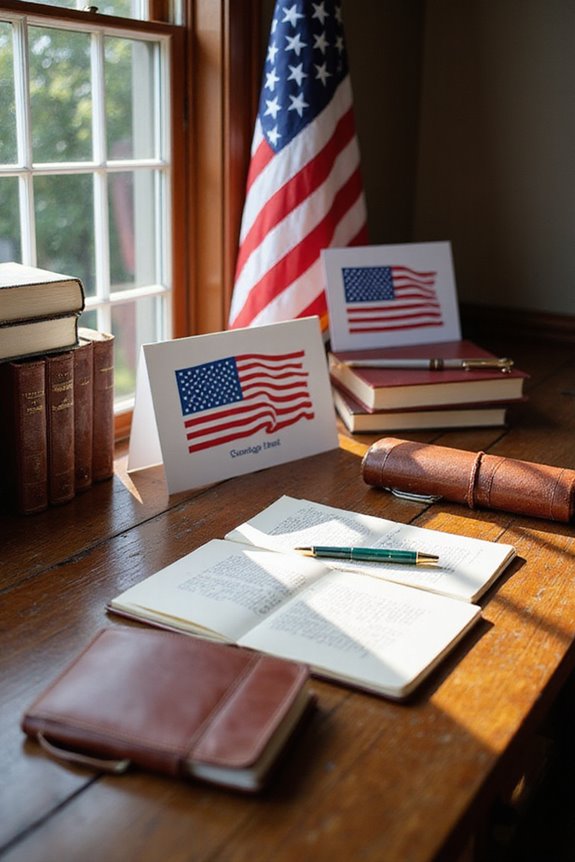Political postcards are an effective tool for boosting voter turnout by combining personal outreach with strategic messaging. Here are key insights:
- Handwritten postcards increase turnout, showing notable results, especially in presidential primaries.
- Fully handwritten messages outperform other formats, cultivating a stronger connection with voters.
- Targeting specific demographics enhances engagement, particularly among younger voters.
- Localized messaging and appealing designs can further increase effectiveness.
Understanding these elements can optimize future postcard strategies, leading to improved voter mobilization outcomes.
Key Takeaways
- Handwritten postcards significantly increase voter turnout, especially among sporadic voters and in presidential primaries.
- Fully handwritten postcards outperform partially handwritten ones, enhancing perceived authenticity and engagement.
- Tailored messaging and values-matched content resonate better with specific voter demographics, boosting turnout.
- Localized designs and culturally sensitive imagery strengthen connections with diverse audiences and enhance message relevance.
- Timing of postcard mailings close to election day reinforces messaging and improves voter recall.
The Impact of Postcards on Voter Turnout
The impact of postcards on voter turnout has been a significant area of research, as they offer a unique method for mobilizing voters.
- Evidence shows that handwritten postcards can increase turnout among targeted groups, especially in presidential primaries.
- In Virginia, these postcards boosted turnout by 0.4%, comparable to door-to-door canvassing.
- Postcard distribution logistics reveal that campaigns can be cost-effective; over 100,000 volunteers sent 15.7 million postcards in 2020.
- Targeting sporadic or low-to-mid propensity voters yields better results than reaching habitual voters.
- Messages emphasizing civic duty and providing logistical information enhance effectiveness. Political postcards can also be customized to include specific voter engagement messages, making them even more impactful.
- Overall, postcards represent a viable voter engagement strategy, demonstrating measurable impacts on turnout across various election types. Additionally, research indicates that fully handwritten postcards were more effective for lower pro-choice support scores, suggesting that the format of the postcard can influence its effectiveness.
Handwritten vs. Partially Handwritten Postcards
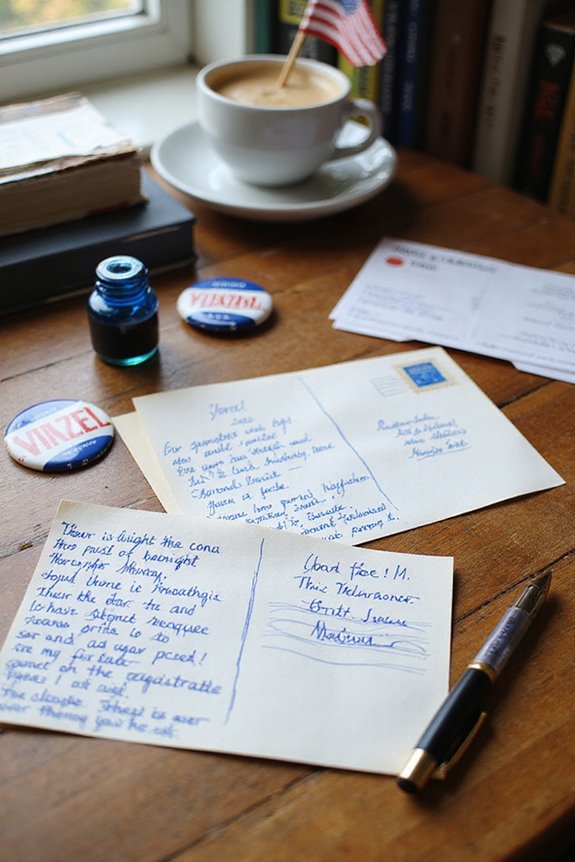
When we consider the effectiveness of handwritten versus partially handwritten postcards, it’s essential to look at recent research findings.
- A 2022 study revealed that completely handwritten postcards increased voter turnout by 0.52% compared to partially handwritten ones.
- Notably, partially handwritten postcards performed worse than no communication at all, suggesting potential negative effects.
- The research indicated that handwriting styles matter: fully handwritten postcards are particularly effective for voters with lower pro-choice issue scores. Additionally, engaging with historical trends in voter mobilization can enhance our understanding of effective strategies.
- While partially handwritten postcards enable greater efficiency, they may lack the perceived authenticity that drives voter engagement.
- As a result, understanding postcard formats and their impact can help us refine our strategies for mobilizing voters effectively and efficiently. However, the study found that there were no statistically significant effects of postcard types on general election voting(no statistically significant effects).
Strategic Messaging for Maximum Effectiveness
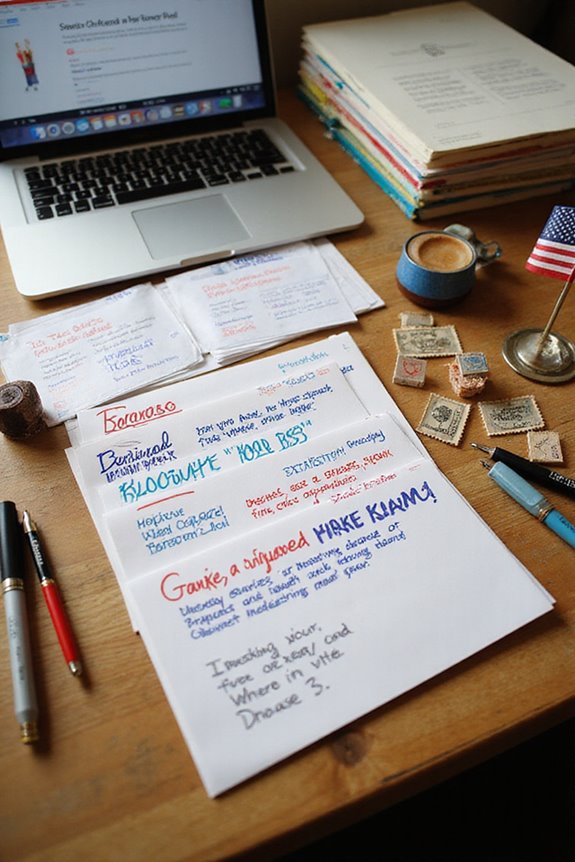
Effective voter outreach relies not only on the format of communication but also on the strategic messaging that accompanies it. To maximize effectiveness, we must focus on message alignment with voter values.
- Values-Matched Messaging: Tailoring postcards to align with recipients’ beliefs greatly boosts turnout, outperforming traditional methods. Research indicates that postcards with values-matched messaging led to a statistically significant increase in voter turnout. Additionally, employing clear explanations of political theories fosters a deeper understanding of the issues at hand, empowering voters to make informed decisions.
- Audience Segmentation: By segmenting our audience, we can personalize messages that resonate with specific priorities, such as economic or healthcare issues.
- Clarity and Simplicity: We should guarantee messages are concise and straightforward, with clear calls to action that avoid jargon.
- Timing and Frequency: Sending postcards closer to election day enhances recall, while a balanced frequency of outreach reinforces the message without overwhelming recipients.
Demographic Considerations in Postcard Campaigns
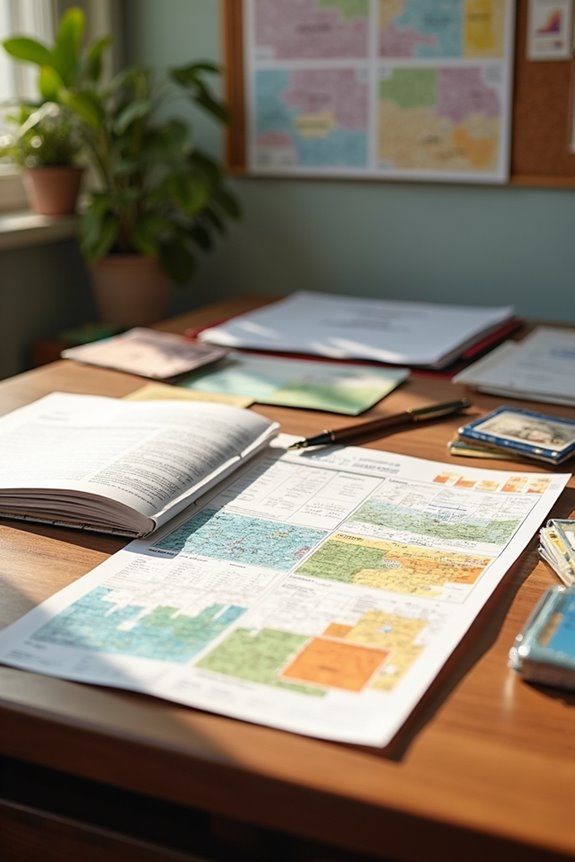
Understanding demographic considerations in postcard campaigns is essential for developing strategies that resonate with specific voter groups.
- Target Audience: Focusing on younger voters aged 18-21 can greatly boost registration rates, with an increase of about 1.8 percentage points compared to older groups. This demographic was particularly responsive to the postcard campaign that aimed to increase voter engagement. Additionally, utilizing eye-catching designs similar to effective political bumper stickers can enhance the appeal of postcards.
- Age Demographics: The impact of postcards on voter turnout is less pronounced for younger voters despite increased registration.
- Effectiveness: Postcards are more effective for voters under 45, while their influence decreases with age.
- Campaign Strategy: Tailoring messaging to younger demographics enhances engagement and can lead to greater voter mobilization efforts.
- Handwritten Postcards: Completely handwritten postcards show higher effectiveness, particularly among younger audiences, further emphasizing the need for targeted approaches.
Geographic Factors Affecting Postcard Success
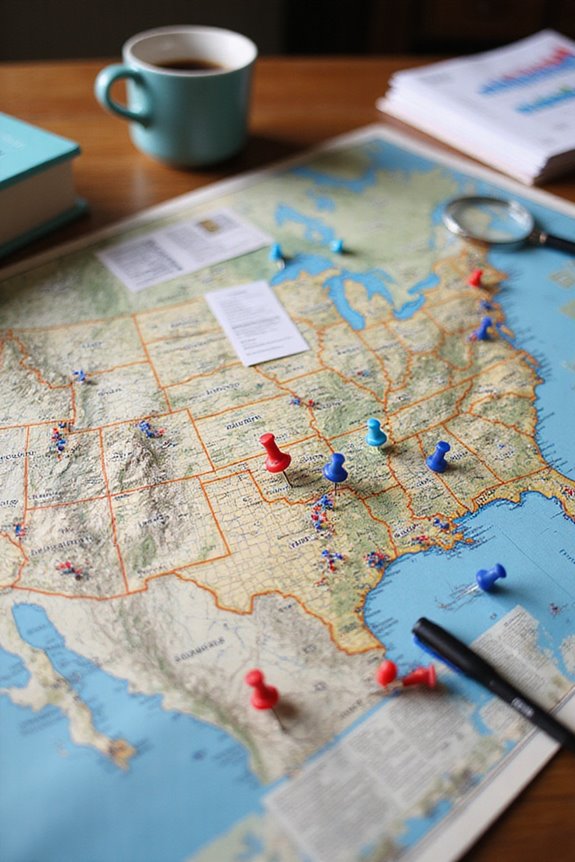
Geographic factors play a pivotal role in the success of postcard campaigns, as they influence how messages resonate with voters.
- Locale-Specific Messaging: Tailoring messages to local issues enhances their effectiveness and relevance.
- Cultural Relevance: Incorporating culturally sensitive designs can better connect with diverse populations.
- Urban vs. Rural: We must reflect the unique concerns of urban and rural areas in our content. Handwritten postcards can also create a personal touch that further engages voters.
- Regional Political Landscapes: Understanding local political environments allows us to craft targeted messages that resonate.
- Visuals and Imagery: Using local imagery can strengthen the connection with the audience.
Best Practices for Organizing Postcard Writing Events
Organizing postcard writing events is a practical way to engage voters and amplify our message. Here are some best practices to reflect on:
- Venue Selection: Choose accessible locations like homes or parks that encourage participation.
- Event Logistics: Plan events during key election periods for maximum impact, ensuring enough seating and comfortable writing space. Consider providing high-quality materials to enhance the visibility of your message.
- Supplies: Provide postcards, pens, and stamps, or request participants to contribute to the cost of supplies.
- Diverse Guest List: Invite family, friends, and community members to foster broader engagement.
- Initial Briefing: Start with a discussion on the importance of postcard writing in voter mobilization.
- Interactive Elements: Incorporate activities or discussions to maintain participant engagement throughout the event.
These strategies help create effective postcard writing events that resonate with voters and encourage civic participation.
Personalization Techniques to Enhance Engagement
Personalization techniques play an essential role in enhancing voter engagement through postcard campaigns. By utilizing personalized messaging, we can greatly increase voter turnout. Here’s how:
- Voter Segmentation: Targeting specific voter demographics allows us to address individual concerns, making our messages more relevant.
- Specific Data Inclusion: Incorporating details like names, polling locations, and deadlines boosts engagement by reducing barriers to voting.
- Tailored Messaging: Addressing issues that matter to recipients fosters empathy and connection, increasing message impact. Additionally, the use of tangible reminders can create a lasting impression on voters, reinforcing the importance of their participation.
- Behavioral Nudges: Mentioning community voting behavior and encouraging past non-voters to participate can effectively enhance engagement.
- Higher Response Rates: Personalized postcards yield a 7.5% response rate, outperforming generic mailers greatly.
Through these techniques, we can create a more effective and engaging postcard campaign.
Visual Appeal and Design Elements
Visual appeal and design elements are essential for crafting effective political postcards that resonate with voters. To enhance impact, we should consider the following:
- Color Psychology: Bright, high-contrast colors attract attention and align with campaign branding. Using patriotic colors like red, white, and blue can evoke trust and national pride.
- Image Selection: High-quality images of candidates engaging with voters enhance credibility. Patriotic imagery, such as flags and eagles, resonates well with American values. Incorporating local issues into the design can further connect with voters on a personal level.
- Typography and Layout: Clear, bold typography improves readability, especially for older voters. Limiting message length and using strategic whitespace guarantees clarity.
Limitations of Current Research on Postcard Effectiveness
While political postcards can be a valuable tool for voter outreach, the current research on their effectiveness reveals several limitations that require our attention.
- Limited Generalizability: Most studies focus on specific voter segments, making it hard to apply findings broadly across the electorate.
- Measurement Challenges: Many studies lack a pure control group, complicating causal attribution and leaving potential biases unaddressed.
- Effect Sizes: Postcard campaigns often yield small, inconsistent effects on turnout, varying by demographics and study design.
- Standardization Issues: There’s no consensus on ideal postcard design or messaging, leading to varied interventions that hinder comparison.
- Message Timing: Research often overlooks how the timing of postcard delivery impacts effectiveness, further complicating results interpretation.
Addressing these limitations is essential for improving postcard effectiveness in future campaigns.
Future Directions for Postcard Campaign Studies
As we look towards the future of postcard campaign studies, it’s essential to focus on several key areas that can enhance their effectiveness.
- Personalization: Understanding how tailored content targets various voter demographics, including age and political affiliation, can improve candidate performance. Research suggests that chaser postcards may amplify previous voter contact and increase turnout.
- Message Content: Researching the emotional appeal and educational impact of different message types may boost voter engagement.
- Design Elements: Exploring visual elements, such as images and decorations, can further enhance postcard effectiveness.
- Targeting Strategies: Effective outreach to low-propensity voters will likely increase participation in elections.
- Technology Integration: Utilizing digital tools to track responses can optimize postcard campaigns and improve overall efficiency.
Frequently Asked Questions
How Can I Get Involved in Postcard Writing Campaigns?
To get involved in postcard writing campaigns, we can start by exploring postcard design options and following helpful writing tips. Let’s connect with local organizations and share our enthusiasm for engaging voters together!
What Are the Costs Associated With Postcard Campaigns?
It is understood that postcard campaigns involve various costs, including printing expenses and mailing costs. By optimizing design and targeting, we can effectively manage expenses, ensuring our outreach remains impactful and budget-friendly for our goals.
Can Postcards Be Used for Non-Political Messaging?
Like a warm letter from a friend, postcards can enhance creative marketing and community outreach. They foster genuine connections, driving engagement and loyalty. We’ve seen their power in various campaigns beyond politics, and it’s impressive!
How Do I Choose the Right Demographic for My Campaign?
To choose the right demographic for our campaign, we need to analyze our target audience carefully. By understanding their interests and behaviors, we can enhance voter engagement and guarantee our message resonates effectively.
What Types of Postcards Are Most Popular Among Voters?
Like a vibrant sunrise, postcard designs that burst with color and clarity often capture voter preferences best. Engaging visuals and tailored messages resonate deeply, making them the popular choice for connecting with our electorate.





